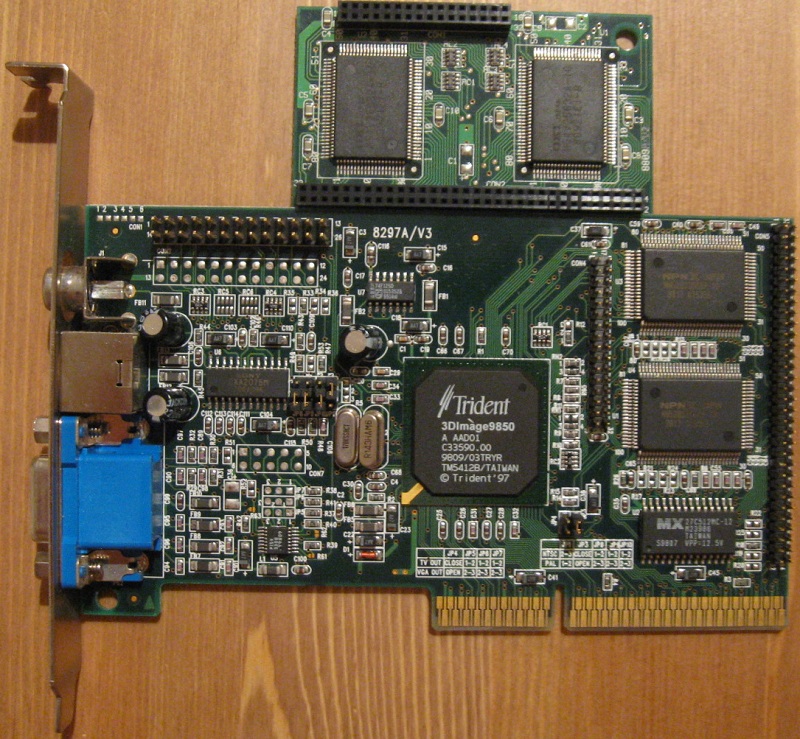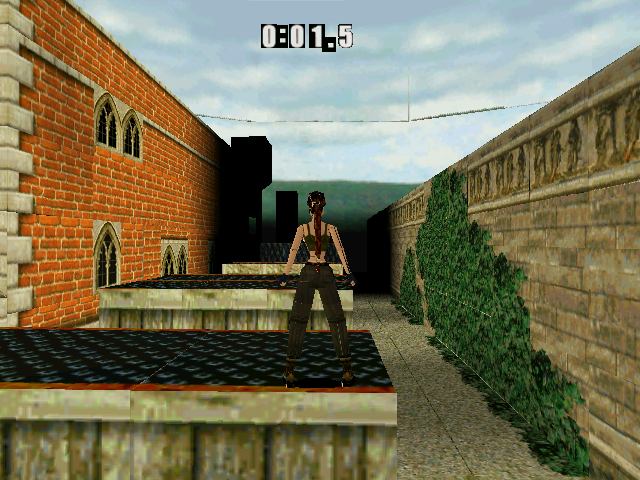3DImáge 9850
The 985 chip was introduced together with 975 as a higher performance alternative. However, there does not seem to be changes big enough to avoid another 3D disaster. Trident like many others was in a race for first full AGP implementation. 985 is such chip, supporting AGP 2x bus with side band addressing. But at first AGP texturing did not seem to be available to me. Playing with Blade 3D this year I discovered high performance dependency upon proper AGP configuration and had to take a second look at the 3DImage 985. Eventually, with last beta driver followed by (re)installation of VIA gart, DiME texturing become operational along with all other features of AGP. Despite several hard lock ups I got through my tests. Suddenly, in certain games the card speed up by some 20 percent and I had to revise this article. Original specs hinted improved triangle setup engine with float to fixed conversion performance of 1.6 Million Triangles/Second. Claim of 60 or 67 megapixel fillrate remained, but Trident also admitted more realistic 45MP/s with bilinear filter enabled. Which makes me think that quite big 4 kB of texture cache in the chip does not have enough logic next to it to do "full speed" bilinear interpolation. But after the review of previous 3DImage the question is rather if it renders properly, than how fast it is.
The card
 Jaton Video-97AGP-3DTV with memory expansion module detached.
Jaton Video-97AGP-3DTV with memory expansion module detached.
I like the looks of this one. According to tools memory is clocked at respectable 84 MHz. Trident says maximum memory interface speed is 100 MHz so perhaps there are even faster clocked cards out there. I would not try to guess the chip clock, especially after finding out how sensitive it is to AGP configuration. Without that knowledge, one should conclude that unless the 9750 tested before was strongly bandwidth constrained, the chip frequency difference should be relatively same as memory. Both 3DImage chips use same driver, another hint of little architectural changes.
Just like for the 975, 985DVD chip with Thama video playback was planned, but this time canceled soon enough to not leave anyone hanging.
Experience
The images produced by 9850 seem more stable to me, but rest assured there are still too many jumping polygons and broken texture filters.
 Ain't that some cool subpixel precision? Visit whole gallery.
Ain't that some cool subpixel precision? Visit whole gallery.Shortly compatibility is almost the same as 975, only Expendable enriched the results. Beta driver needed for AGP has some troubles tough, Hellbender now cannot be started. The big AGP aperture would further extend losses by Forsaken, Motoracer 2, Populous, and Ultimate Race Pro, fortunately I tried values below 16 MB. Even then the Motoracer 2 remains limited to 640x400 resolution, despite all my tweaking efforts.
 Duh.
Duh.There is but one improvement: 985 sucks consistently. No more bilinear interpolation on/off, it looks this bad all the time unless the 985 decides to leave some textures completely alone. Other than that even this 3D Image was great troll among 3d accelerators. My condolences to every gamer who owned this gem. I found another volatility:

What you see on the first picture are horrible texture combine artifacts at default setting. These almost go away when Z-buffering is disabled, which you can see after clicking on that image. By the way speed gain was quite small. Same thing happens with all newer games using lightmapping, so depth accuracy may be another area where Trident cut corners too short.
Performance
Lets try Diamond A50 with SiS 6326AGP for comparison. 9850 without DiME scored 17% better then 9750 EDO, but it is not enough to catch A50. It seems slower 6326 cards would equal 9850 performance in both average and minimal framerates, but still with much superior gaming experience. With DiME some results saw nice improvements, increasing average framerate by ~13%. This is still insufficient to change the overall picture. 9750 with 2/3 of speed of 6326AGP looks quite hopeless now.

Conclusion
If only speed was of concern I could have just say 985 showed some reasonable framerates for its price. Trident however did not deliver usable 3d accelerator in the form of 3DImage. These secured market share for the time, yet it is obvious why they also started the downfall of Trident. Both 975 and 985 chips produced some of the worst 3d rendered images in a year when the market as a whole was maturing. Soon Trident's desktop products were able to sell only at dirt cheap prices and even notebook market was more and more insecure. Throughout 1998 Trident was silent, perhaps jumping into the trap of Microsoft's Talisman. Finally their new 3d chip was ready in early 1999 and unlike 3DImage it fully delivered on its promises. While being cheap the Blade 3D was high quality 2D and 3D renderer with full DirectX 6 compliance and sufficient performance for 640x480 gaming. Single cycle trilinear filter, even anisotropic filter support, texture compression, 11 LOD steps, true color 3d rendering, 1/16 sub-pixel precision and OpenGL driver out of the box made a good impression from the beginning. In the meantime however gamers lost confidence in Trident and reviews were scarce. Another letdown was end of integrated graphics cooperation with VIA, as the chipset maker aimed to swallow S3. Trident's notebook business was still fine because their architectures were quite power efficient, but could not feed the company with enough income. As next generation of Blade XP products slipped under the radar of the press and too-good-to-be-true XP4 was not delivered, the story of Trident graphics came to an end. The division was spun off and merged with graphics division of SiS to start a new company named XGI. Thus, their last design called XP5 saw the light of the day in Volari V3. Trident Micro found new focus in video processors for digital televisions and other multimedia devices and today still looks well alive.